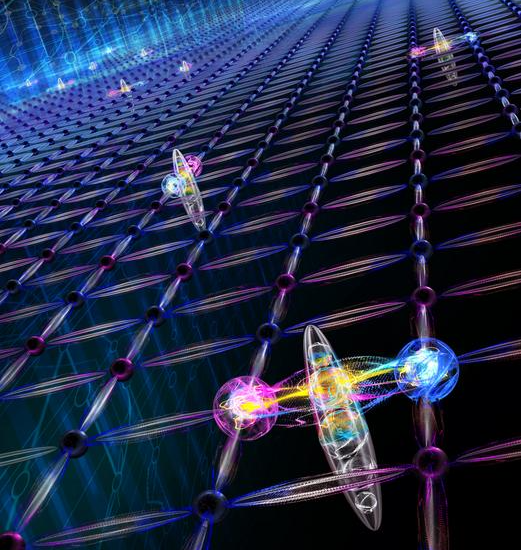Quantum Computer Simulates a 2D Electromagnetic Vacuum
Simulations are the main tool for studying fundamental particle problems ranging from determining the possible states of quantum matter to understanding the goings-on inside a neutron star. Yet current computational methods can’t tackle the fundamental particle interactions that underlie the standard model of particle physics beyond a single dimension. Now a five-level version of a quantum bit—a ququint—brings these computations into reach [1]. In a first test of the new quantum processing tool, researchers simulated a 2D picture of charged particles interacting in an electromagnetic vacuum.
In general, problems that involve dynamics in gauge theories—the theories that explain interactions between fundamental particles through the exchange of force fields—require new computational methods. The same is true for situations involving a lot of particles crammed together, such as in neutron stars or the early Universe. Advanced simulations would also allow researchers to scout out quantum phase diagrams to show which states of matter are possible in nature.
Quantum computers simulate particle interactions by significantly truncating the mediating force fields. “In 1D you can even get away without including all the force fields,” explains Christine Muschik, a theoretical physicist at the University of Waterloo in Canada.
Force-mediating fields, such as the electromagnetic field that influences how electrons and positrons interact, have infinite dimensions. In practice, calculations break down multilevel fields like these into two-level representations that are accessible to qubits, the currency of quantum computing.
But the quantum systems that host the qubits have an inherently multilevel structure. In the case of trapped-ion computing, for example, the quantum system has eight electronic energy levels, even though only two are used for a qubit. The hardware controls all the energy levels, “so you might as well encode information in them,” says Martin Ringbauer, an experimental physicist at the University of Innsbruck in Austria. In 2022, Ringbauer’s lab showed it was possible to perform basic logic operations on d-dimensional qudits up to five levels. But at the time, few algorithms had been developed for multiqudit circuits, and “implementations were very simple,” Ringbauer says.
Using Muschik’s quantum electrodynamics algorithm and Ringbauer’s calcium-ion ququints, the researchers set out to simulate electrons and positrons interacting in an electromagnetic vacuum. The multilevel electromagnetic field is naturally suited to representation with multilevel qudits, Muschik says. “If we include more levels, we reach greater accuracy. The problem is asking to be solved this way.”
In trapped-ion quantum computing, laser beams manipulate ions that are coupled via shared motion in the trap. “The charged particles repel each other and feel each other’s movements,” Ringbauer says. The question then becomes how to translate interactions described by an algorithm into usable laser pulses. To do that, Ringbauer’s team developed a new entanglement operation based on controlled rotations. “You get particle-pair creations and, depending on the state of these particles, you need to adjust the state of the field.” Some ions represent fields, others represent matter, and all need to be coupled: When the state of matter changes, the field must change with it.
As in other particle-physics trapped-ion simulations, the researchers represented space as a lattice. The nodes of the lattice represented matter and the gaps between fields. They started with a state that corresponded to a single “vacuum pixel” of the 2D grid. They then measured the magnetic energy in it, as well as the particle count, as a function of time. In the resulting pixel, the researchers observed the electromagnetic vacuum. “It consists of a complex dance of spontaneous particle–antiparticle-pair creation and annihilation processes,” Mischuk says. The demonstration showcases the fidelity of the five-level entanglement compared to a traditional two-level qubit circuit. “Fewer gates have to be executed, and fewer errors accumulate,” Ringbauer says.
The next step is adding quarks and gluons to the simulation. “Now is the time to start exploring how to use qudits and make them shine,” Mischuk says. She envisions using them to study multidimensional problems in materials science and chemistry in addition to those in particle physics. And from the experimental side, “this is still a big playground for us. We’re just starting to explore what we can do,” Ringbauer says.
Irfan Siddiqi, a physicist at the University of California, Berkeley, calls the work “an elegant result.” He explains, “You can encode additional descriptors in multiple levels, and that’s more convenient for carrying the most critical information that you want.” He comments that qudits become yet more powerful when all five levels are fully entangled, going beyond local pair-wise interactions between specific levels.
“The real challenge is making something that’s fully entangled,” Siddiqi says. He makes a playful analogy to people delivering ingredients to a pastry shop. Ingredient carriers with two arms each transport flour, eggs, butter, sugar, and more, with one item in each arm—a very inefficient way to deliver multiple ingredients, requiring many people and multiple trips. Third or fourth arms for each carrier would greatly improve the resource efficiency of the process. “But more efficient still would be multiarm guys who talk to each other about what they’re doing,” he says.
Ringbauer says it is true that their system is likely not as entangled as it could be, but their aim was to simulate a specific physics model. “We provide the platform, which uses qudits to faithfully capture the physics, but the degree of entanglement is dictated by the model and depends on the regime that is simulated,” he says.
–Rachel Berkowitz
Rachel Berkowitz is a Corresponding Editor for Physics Magazine based in Vancouver, Canada.
References
- M. Meth et al., “Simulating two-dimensional lattice gauge theories on a qudit quantum computer,” Nat. Phys. (2025).





